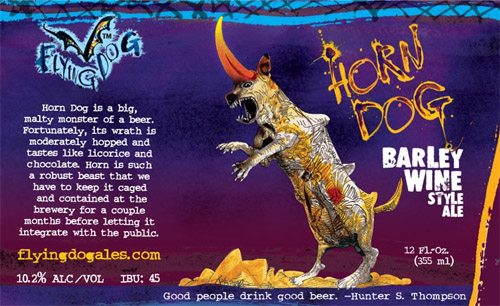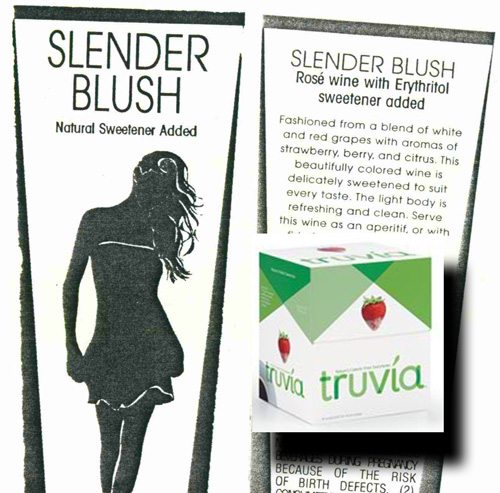Would anyone expect this to be a big seller in the US? In Macedonia? It’s not clear why it ought to be considered “diluted,” since it meets the 80 proof threshold required for regular brandy. For the answer, click the label.
Barleywine; Is it Beer, Wine or Both?
Beeradvocate shows over 400 barleywines, from the US alone. Because this type is common, but not nearly so well known as stout or rum, for example, we wanted to take a closer look. Beeradvocate says:
Despite its name, a Barleywine (or Barley Wine) is very much a beer, albeit a very strong and often intense beer! In fact, it’s one of the strongest of the beer styles. Lively and fruity, sometimes sweet, sometimes bittersweet, but always alcoholic. … English varieties are quite different from the American efforts, what sets them apart is usually the American versions are insanely hopped to make for a more bitter and hop flavored brew, typically using American high alpha oil hops. English versions tend to be more rounded and balanced between malt and hops, with a slightly lower alcohol content, though this is not always the case. … Most Barleywines can be cellared for years and typically age like wine. … Average alcohol by volume (abv) range: 8.0-15.0%.
Wikipedia provides additional details : “In the United States, barley wines are required … to be called ‘barley wine-style ales.’ Though this could be taken by some to imply that they are not truly barley wines, in fact it only means that they, like all barley wines, are not truly wines.” Bass was first, around 1900, and the term stems from the fact that many barleywines have an alcohol content similar to that for wine.
The above label nicely demonstrates the US “requirement” to add “Style Ale.” Based on this TTB definition for “wine,” we don’t see why it’s so obviously beer rather than wine: “When used without qualification, the term includes every kind (class and type) of product produced on bonded wine premises from grapes, other fruit (including berries), or other suitable agricultural products and containing not more than 24 percent of alcohol by volume. The term includes all imitation, other than standard, or artificial wine and compounds sold as wine.” We do acknowledge, however, that this definition (for “malt beverage”) probably fits better.
Bacon Flavored Vodka
Wait no longer; bacon flavored vodka is here. The company says: “Yes, Bacon Vodka. Bakon Vodka is a superior quality potato vodka with a savory bacon flavor. It’s clean, crisp, and delicious. This is the only vodka you’ll ever want to use to make a Bloody Mary, and it’s a complementary element of both sweet and savory drinks. ”
Dozens of blogs chronicle the public’s fascination with bacon, from the bacon suitcase, to the bacon bra, to . . . bacon flavored vodka. Salon attempts to explain why bacon is such a huge phenomenon:
Americans have a guilty relationship with food, and perhaps no food is more guilt-inducing than bacon — forbidden by religions, disdained by dietitians and doctors. Loving bacon is like shoving a middle finger in the face of all that is healthy and holy while an unfiltered cigarette smolders between your lips.
“Bacon has the perfect balance of sweet, salty, smoky flavor, and the perfect balance of meaty and crispy texture,” says James Villa, the author of “The Bacon Cookbook.” “It’s the most perfect food ever created by the gods.”
John T. Edge, author and director of the Southern Foodways Alliance, says, “Bacon is a sort of 21st century tattoo, a marker that declares the wearer to be a badass, unbeholden to convention.”
The bacon-beverage connection may be stronger than previously assumed. Aside from Bakon, we have seen many other alcohol beverages featuring various meats. This blog covers bacon and beer, and Dan Philips founded both a great wine company and a premium bacon company. He has said: “Bacon is sex in a skillet. … It’s the ultimate aphrodisiac for all living things. Except pigs, of course.”
What Could be Better than Seven Daughters?
What could be better than seven daughters? Would eight be better?
Here is Seven Daughters wine. It is made with — you guessed it — seven varietals of wine. Is this better than one or a few great varietals? Would 12 be better still? We wonder if this is a good idea for making superior wine, a good idea for marketing, both, or neither.
We haven’t tasted the wine, but we do think this makes for a good, clean logo and a good theme. The website is about as pretty as the second prettiest daughter. This wine is bottled by Monterey Wine Co. of King City, California and seems to be marketed by Terlato Wine Group.
DISCUS Comment; Top 6 Things to Know
It is likely that all beer, wine and spirits labels will change dramatically in the near future. TTB has been working on new rules since CSPI and other groups submitted a petition in 2003. The new rules would require a “Serving Facts” panel on every container. This panel would include a lot more information, such as the typical serving size, number of servings per container, calories, carbohydrates, protein and fat. Because this is a big, controversial change, TTB has received more than 18,000 public comments during the past few years. There are far too many comments for most people to review, and so we will highlight and summarize the most noteworthy comments here. The most recent proposal and comments are here. This is comment 13 in a series; to see others, click on the “serving facts” tag below.
The Distilled Spirits Council of the US (DISCUS) is a trade association representing spirits producers and marketers. DISCUS submitted a 14-page comment, plus 6 pages of footnotes and a 61-page survey making these points:
- Some DISCUS members market wine and beer, so DISCUS has a broad perspective.
- DISCUS opposes the proposed Serving Facts panel, whether required or optional. It will not provide sufficient information unless it explains that a standard drink contains 0.6 ounces of alcohol, and explains standard serving sizes for beer, wine and spirits. Anything less would force consumers into “guesswork.”
- “It is without doubt [that this rule] is one of the most significant undertakings by the Bureau in the last 20 years.”
- TTB should provide more flexibility, especially for small containers, to allow the information to be conveyed by a linear format, or an 800 number, or a website.
- TTB should allow a five-year rather than a three-year phase in, due to the scope of this rule.
- A survey of 1,221 adults found that 61% support nutrition labels on beverage alcohol . 69% rated “alcohol content per serving” as most important and 85% consider the definition of a standard drink helpful.
Erythritol in Slender Wine
FDA said Truvia looks okay on December 17, 2008 and TTB approved this wine, with erythritol, a mere two days later. It is difficult to distinguish among erythritol, stevia, Truvia, rebiana and many other new sweeteners hitting the market. Erythritol seems to be a component of Truvia. Fooducate says erythritol is:
a sugar alcohol, a carbohydrate found naturally in various fruits and vegetables. Used in both Purevia and Truvia. It helps them mimic the texture and mouthfeel of table sugar.
Rebiana is:
the trade name for a stevia-derived sweetener developed jointly by the Coca Cola Company and Cargill. According to Cargill, rebiana is “the best tasting part of the stevia leaf.”
Truvia is:
Cargill’s consumer brand of Rebiana-based sweetener packs.
And Stevia is:
a South American Plant from the sunflower family, grown and used by locals for its sweet tasting leaves. Stevia Extracts are 200-300 times sweeter than sugar, but contain no carbohydrates (calories).
Cargill, finally, on its Truvia FAQ explains that erythritol “is a sugar alcohol, a carbohydrate found naturally in several fruits. Erythritol doesn’t lead to tooth decay, is safe for people with diabetes and in reasonable amounts does not lead to gastrointestinal side effects (in other words, no gas or bloating).”






